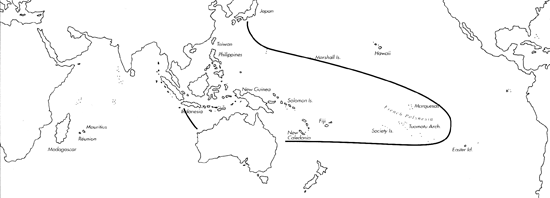Range: Indonesia to Marquesas, Queensland to N.W. Australia; reports from localities further west in the Indian Ocean probably refer to C. striatellus.
Description: Medium-sized to moderately large, moderately solid to solid. Last whorl ventricosely conical or conical; outline convex at adapical fourth or third, less so or straight below. Shoulder angulate. Spire of low to moderate height, outline slightly convex to slightly concave. Larval shell of about 3-3.5 whorls, maximum diameter about 0.8 mm. First 0.5 postnuclear whorls tuberculate, grading to smooth within adjacent 2.5 whorls. Teleoconch sutural ramps flat, often slightly concave in late whorls; with 1 increasing to 4-6 or sometimes 8 spiral grooves; spiral sculpture may be weak and fine on last 2 ramps. Last whorl with often granulose spiral ribs on basal third, occasionally extending to shoulder.
| Shell Morphometry | ||
|---|---|---|
| L | 40-75 mm | |
| RW | 0.20-0.75 g/mm | |
| (L 40-70 mm) | ||
| RD | 0.54-0.65 | |
| PMD | 0.78-0.88 | |
| RSH | 0.06-0.16 | |
Ground colour usually cream to yellowish brown. Last whorl with a variably broad yellowish tan to brown spiral band on each side of centre, either solid or interrupted, sometimes blending with adjacent areas to produce an almost uniform colouration. Bands may be gradually reduced and replaced by rows of irregular dark brown axial markings sometimes extending to shoulder. Well separated, dotted, dashed or solid brown spiral lines often extend from base to shoulder. Base and siphonal fasciole contrastingly darker brown than adjacent area. Apex pale yellow. Later sutural ramps with axial or radial dark brown markings. Aperture uniformly white to cream.
Periostracum yellow to brown, variably thin, translucent to opaque, with tufted spiral ridges on last whorl and fringed sutural ramps.
Animal yellow; dorsum of foot paler medially, sometimes with a black spot at posterior end, otherwise immaculate or with sparse brown mottling at centre of anterior part and laterally. Tentacles immaculate or with a black ring. Siphon with 1 or sometimes 2 dark brown or black black half-rings 1/2 or 1/3 the length from the tip (Pl. 75, Fig. 37; Pl. 80, First row, left and right) (Chaberman, pers. comm., 1981; Estival, 1981 & unpubl. observ.).
Habitat and Habits: Intertidal to about 50 m; on sand, often under coral (Cernohorsky, 1964) or on sand with algae (Estival, 1981; Richer de Forges & Estival, 1984; Tirard, pers. comm., 1989). Egg diameter of about 214 µm predicts a minimum pelagic period of about 22 days (Philippines; Perron & Kohn, 1985).
Discussion: C. ferrugineus is most similar to C. planorbis, from which it is not distinguishable by size and shape of the shell. For comparison of C. ferrugineus with C. planorbis as well as with C. striatellus, C. circumactus and C. swainsoni, see the DISCUSSIONS of those species. C. ferrugineus is usually called "C. planorbis Born". However, the lectotype of C. planorbis has a faded violet blotch at the anterior end of its aperture, a character also stated in Born's description. Röckel (1981) considered C. vulpinus and C. ferrugineus to refer to the same species, because the lectotypes of both C. vulpinus (Pl. 21, Fig. 1) and C. ferrugineus (Pl. 21, Fig. 9) are white inside, and he selected the former as the name for the species. However, Hwass himself stated in his diagnosis of C. vulpinus "intus violacea", and we cannot exclude, that the lectotype lost its violet blotch by fading. We therefore provisionally assign C. vulpinus to C. planorbis. C. chenui (Pl. 21, Fig. 8) refers to a colour form of C. ferrugineus with spiral rows of dark axial markings replacing the brown spiral bands on the last whorl. Originally described from New Caledonia, it is also known from Philippines, co- occurring and intergrading with the typical form in both regions. C. mirmillo represents a cream white variant with pale yellow cream spiral bands on both sides of the centre. C. sophiae (Pl. 21, Fig. 10) is based on a variant with granulose spiral ribs to the shoulder. C. loebbeckeanus is very similar to typical C. ferrugineus, with about 20 fine dark spiral lines from base to shoulder. We consider it a colour form of C. ferrugineus known from French Polynesia and Papua New Guinea.

C. ferrugineus range map
This section contains verbatim reproductions of the accounts of 316 species of Conus from the Indo-Pacific region, from Manual of the Living Conidae, by Röckel, Korn and Kohn (1995). They are reproduced with the kind permission of the present publisher, Conchbooks.
All plates and figures referred to in the text are also in Röckel, Korn & Kohn, 1995. Manual of the Living Conidae Vol. 1: Indo-Pacific Region.
The range maps have been modified so that each species account has it own map, rather than one map that showed the ranges of several species in the original work. This was necessary because each species account is on a separate page on the website and not confined to the order of accounts in the book.